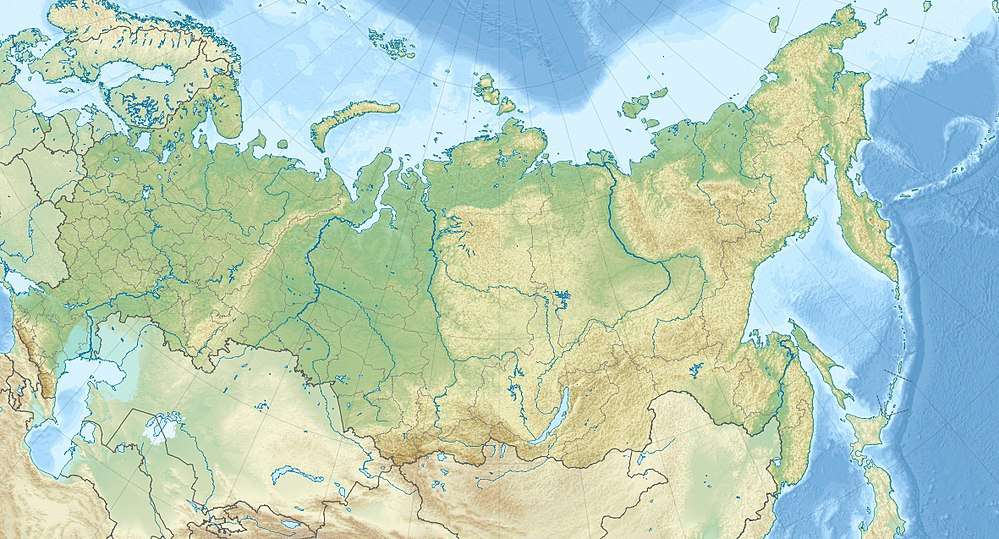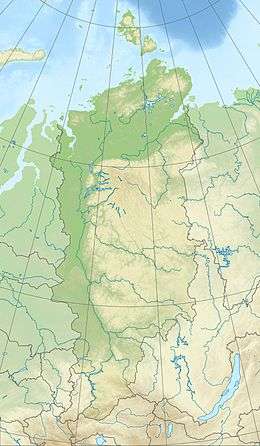Lake Cheko
Lake Cheko (Russian: Чеко) is a small freshwater lake in Siberia, near the Podkamennaya Tunguska River, in what is now the Evenkiysky District of the Krasnoyarsk Krai.
| Lake Cheko | |
|---|---|
 Lake Cheko Location in Russia  Lake Cheko Lake Cheko (Krasnoyarsk Krai) | |
| Location | near Podkamennaya Tunguska River, Siberia |
| Coordinates | 60.964°N 101.86°E |
| Native name | Чеко |
| Basin countries | Russia |
| Average depth | 50 metres (160 ft) |
Dimensions and environs
Lake Cheko is a small bowl-shaped lake. It is about 500 metres (1,600 ft) long, and 300 metres (980 ft) wide 50 metres (160 ft) deep.[1][2]
In the lake flows the Kimchu River (Russian: кимчу), which flows into the Chunya River (Russian: Чуня), which in turn flows into the Podkamennaya Tunguska.[3][4]
Possible relation to the Tunguska event
Lake Cheko is roughly 8 kilometres (5.0 mi) north-northwest[6] of the epicenter of the Tunguska event.[7] The lake is inside the blast zone,[8] and in the probable direction of whatever made the Tunguska event.[9]
It has been connected by some scientists to the Tunguska event and they postulate the lake was created by a chunk of the exploding meteorite that struck the ground.[10][11] In 2017, that theory was disputed by Russian scientists by proving that the lake is older, possibly even much older, than the Tunguska Event.[12]
Age of the lake
Some scientists have speculated that Lake Cheko was created during the Tunguska event of 1908, an explosion that destroyed more than 2,000 km2 (800 sq mi) of Siberian taiga. It is suggested that the lake, which lies approximately 8 kilometres north-north-west of the event hypocenter, was formed by a fragment which struck the ground.[10] More recent evidence suggests at least a portion of the lake is over twice as old as the date of the meteorite.[12]
| External image | |
|---|---|
Other varied evidence
A 1961 investigation estimated the age of the lake to be at least 5000 years, based on meters-thick silt deposits on the lake bed.[13] However, a 2001 paper concluded that the sediments, isotopes, and pollen "suggest that Lake Cheko formed at the time of the Tunguska Event."[10] Their recent research indicates that only a metre or so of the sediment layer on the lake bed is "normal lacustrine sedimentation", indicating a much younger lake of about 100 years.[14]
Acoustic-echo soundings of the lake floor offer some further support for the impact hypothesis, revealing a conical shape for the lake bed, which could be consistent with an impact crater. Also, the lake's long axis points to the hypocenter of the Tunguska explosion, about 7.0 km away.[15] Magnetic readings also indicate a possible meter-sized chunk of rock below the lake's deepest point, which may be a fragment of the colliding body.
In 2008, a BBC News story on the 100th anniversary of the Tunguska Event mentioned that researchers at Imperial College London had pointed out that many of the trees surrounding the lake are older than 100 years, which suggests that the lake could not have been created by an impact in 1908.[16] The researchers also pointed out other problems, including the morphology of the lake and the surrounding terrain, the lack of impactor debris and ejecta, noting that the characteristics of the impactor required by the impact theory are inconsistent with existing models of the known features of the event.[17]
However, researchers from the University of Bologna investigated the lake bed in 2009 and, based on evidence such as sedimentation, reaffirmed the conclusions of the 2001 paper, that Lake Cheko formed at the time of the Tunguska Event.[18][19]
Additional research by Russian scientists in 2017 appeared to contradict a purely Tunguska Event-based formation theory. Core samples of sediment taken from the deepest part of the lake demonstrated an age of up to 280 years, suggesting that at least a portion of the lake existed prior to the meteorite striking.[12][20]
References
- Chandler, David (27 June 2007). "Siberian lake could have been made by asteroid blast". News@nature. doi:10.1038/news070625-8. Retrieved 14 May 2018.
- Cristina Valsecchi, Maria (November 7, 2007). "Crater From 1908 Russian Space Impact Found, Team Says". National Geographic. Retrieved 14 May 2018.
- Florenskiy, K P (May 1962). "PRELIMINARY RESULTS FROM THE 1961 COMBINED TUNGUSKA METEORITE EXPEDITION". Meteoritica. Retrieved 18 May 2018.
- Kulik, L. (1935). "On the Fall 'Of the Podkamennaya Tunguska Meteorite In 1908". Contributions of the Society for Research on Meteorites. 1: 35–39. doi:10.1111/j.1945-5100.1935.tb00263.x.
- Dockweiler, T. (July 2007). "Cosmic Collision: The Lake Cheko — Tunguska 1908 Bolide Event" (PDF). Science Newsletter. Retrieved 19 May 2018.
- "The Tunguska Mystery--100 Years Later". Retrieved May 18, 2018.The Tunguska Mystery--100 Years Later
- Fantucci, Rosanna; Romano, Serra; Kletetschka, Gunther; Di Martino, Mario. "The Tunguska event and Cheko lake origin: Dendrochronological analysis". researchgate.net. Retrieved May 19, 2018.
- Gasperini, Luca; Cocchi, Luca; Stanghellini, Carlo; Carmisciano,C. (May 2012). "Magnetic and seismic reflection study of Lake Cheko, a possible impact crater for the 1908 Tunguska Event". researchgate.net. Retrieved 19 May 2018.
- Gasperini, L.; et al. (2001). "Geophysical/sedimentological study of a lake close to the centre of the great 1908 Siberian (Tunguska) Explosion" (PDF). NGF Abstracts and Proceedings (1): 29–30. Retrieved 2008-05-27.
- Rincon, Paul (2007-06-26). "Team makes Tunguska crater claim". BBC News. Retrieved 2013-02-15.
- "Tunguska Event: Russian Scientists Debunk Meteorite Theory". Sputnik News. 2017-01-18. Retrieved 2017-01-19.
- Florenskiy, K. P. (1963). "Preliminary results from the 1961 combined Tunguska meteorite expedition". Meteoritica. 23: 3–29. Retrieved 2007-06-26.
- Gasperini, L.; Bonatti, Enrico; Longo, Giuseppe; et al. (April 2008). "Reply - Lake Cheko and the Tunguska Event: impact or non-impact?". Terra Nova. 20 (2): 169–172. Bibcode:2008TeNov..20..169G. doi:10.1111/j.1365-3121.2008.00792.x.
- Gasperini, L.; et al. (June 2008). "The Tunguska Mystery". Scientific American. 298 (6): 80–86. Bibcode:2008SciAm.298f..80G. doi:10.1038/scientificamerican0608-80. PMID 18642546.
- Rincon, Paul (2008-06-30). "Fire in the sky: Tunguska at 100". BBC News. Retrieved 2008-07-01.
- Collins, G. S.; Artemieva, N.; Wünnemann, K.; Bland, P. A.; Reimold, W. U.; Koeberl, C.; et al. (2008). "Evidence that Lake Cheko is not an impact crater". Terra Nova. 20 (2): 165–168. Bibcode:2008TeNov..20..165C. doi:10.1111/j.1365-3121.2008.00791.x.
- Gasperini, Luca; et al. (2009). "Sediments from Lake Cheko (Siberia), a possible impact crater for the 1908 Tunguska Event". Retrieved 30 June 2010.
- Gasperini, Luca; Bonatti, Enrico; Albertazzi, Sonia; Forlani, Luisa; Accorsi, Carla A.; Longo, Giuseppe; Ravaioli, Mariangela; Alvisi, Francesca; et al. (December 2009). "Sediments from Lake Cheko (Siberia), a possible impact crater for the 1908 Tunguska Event". Terra Nova. 21 (6): 489–494. Bibcode:2009TeNov..21..489G. doi:10.1111/j.1365-3121.2009.00906.x. Retrieved 30 June 2010.
- "Ученые опровергли одну из связанных с Тунгусским метеоритом гипотез". Interfax.ru (in Russian). 18 January 2017. Retrieved 4 February 2017.